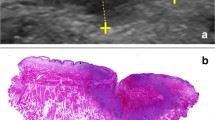Abstract
Tongue is one of the most common subsites involved by oral cancer. Improved surgical care and adjuvant therapy, along with better rehabilitation has significantly improved long-term survival and quality of life in patients with oral cancer. Primary surgical treatment is the preferred modality of treatment in cancers of the oral tongue. Although the surgical techniques have remained unchanged, various devices have been used to aid primary tumour resection, with a view to reduce bleeding and scarring. The purpose of this study is to compare resection of oral tongue tumours using ultrasonic coagulation device with conventional electrodiathermy. This study was conducted to compare histological margins and duration of surgery between ultrasonic coagulation device and electrodiathermy in the resection of oral tongue tumours. A retrospective analysis was performed comprising patients undergoing wide excision for squamous cell carcinoma of the lateral tongue, with either ultrasonic coagulation device or conventional electrodiathermy at Our Institute in Mumbai, India, from October 2015 to December 2016. Single factor ANOVA with the level of significance set at 95% and alpha value of 0.05. Patients who underwent excision with ultrasonic coagulation device better histologically tumour-free margins (except posterior margin) (p values—anterior margin, posterior margin, lateral margin and deep margin 0.0045, 0.59, 0.011 and 0.00013 respectively) and lesser operative time when compared with conventional electrodiathermy. Ultrasonic coagulation device was effective in providing adequate oncologically safe margins in carcinoma tongue.



Similar content being viewed by others
References
Sankaranarayanan R, Ramadas K, Thomas G, Muwonge R, Thara S, Mathew B et al (2005) Effect of screening on oral cancer mortality in Kerala, India: a cluster-randomised controlled trial. Lancet 365(9475):1927–1933
Kulkarani MR (2013) Head and neck cancer burden in India. Int J Head Neck Surg 4:29–35
National Comprehensive Cancer Network (2011) NCCN guidelines and clinical resources. National Comprehensive Cancer Network, Fort Washington
Metternich FU, Wenzel S, Sagowski C, Ja kel T, Koch U (2002) The “Ultracision Harmonic Scalpel” ultrasound activated scalpel: initial results in surgery of the tongue and soft palate. HNO 50:733–738
Bernier J, Cooper J, Pajak T, van Glabbeke M, Bourhis J, Forastiere A et al (2005) Defining risk levels in locally advanced head and neck cancers: a comparative analysis of concurrent postoperative radiation plus chemotherapy trials of the EORTC (#22931) and RTOG (# 9501). Head Neck 27(10):843–850
Scholl P, Byers RM, Batsakis JG, Wolf P, Santini H (1986) Microscopic cut-through of cancer in the surgical treatment of squamous carcinoma of the tongue: prognostic and therapeutic implications. Am J Surg 152:354–360
Brandwein-Gensler M, Teixeira MS, Lewis CM (2005) Oral squa- mous cell carcinoma: histologic risk assessment, but not margin status, is strongly predictive of local disease-free and overall survival. Am J Surg Pathol 29:167–178
Sparano A, Weinstein G, Chailian A, Yodul M, Weber R (2004) Multivariate predictors of occult neck metastasis in early oral tongue cancer. Otolaryngol Head Neck Surg 131:472–476
Belli G, Fantini C, Ciciliano F et al (2003) Pancreaticoduodenectomy in portal hypertension: use of the Ligasure. J Hepato-Biliary-Pancreat Surg 10:215–217
Ou CS, Harper A, Liu YH, Rowbotham R (2002) Laparoscopic myomectomy technique: use of colpotomy and the harmonic scalpel. J Reprod Med 47:849–853
Palazzo FF, Francis DL, Clifton MA (2002) Randomized clinical trial of Ligasure versus open haemorrhoidectomy. Br J Surg 89:154–157
Cristalli G, Mercante G, Covello R, Sperduti I, Cristalli MP, Spriano G (2012 Dec) Histopathological assessment in glossectomy: harmonic shears versus monopolar electrosurgery pilot study. Otolaryngol Head Neck Surg 147(6):1076–1082
Author information
Authors and Affiliations
Corresponding author
Ethics declarations
Conflict of Interest
The authors declare that they have no conflict of interest.
Rights and permissions
About this article
Cite this article
Rao, K.N., Jagade, M., Kale, V.D. et al. Margin Status and Duration of Surgery in Resection of Tongue Carcinoma with Ultrasound Coagulation Device: a Comparative Study. Indian J Surg Oncol 9, 501–504 (2018). https://doi.org/10.1007/s13193-018-0785-z
Received:
Accepted:
Published:
Issue Date:
DOI: https://doi.org/10.1007/s13193-018-0785-z




